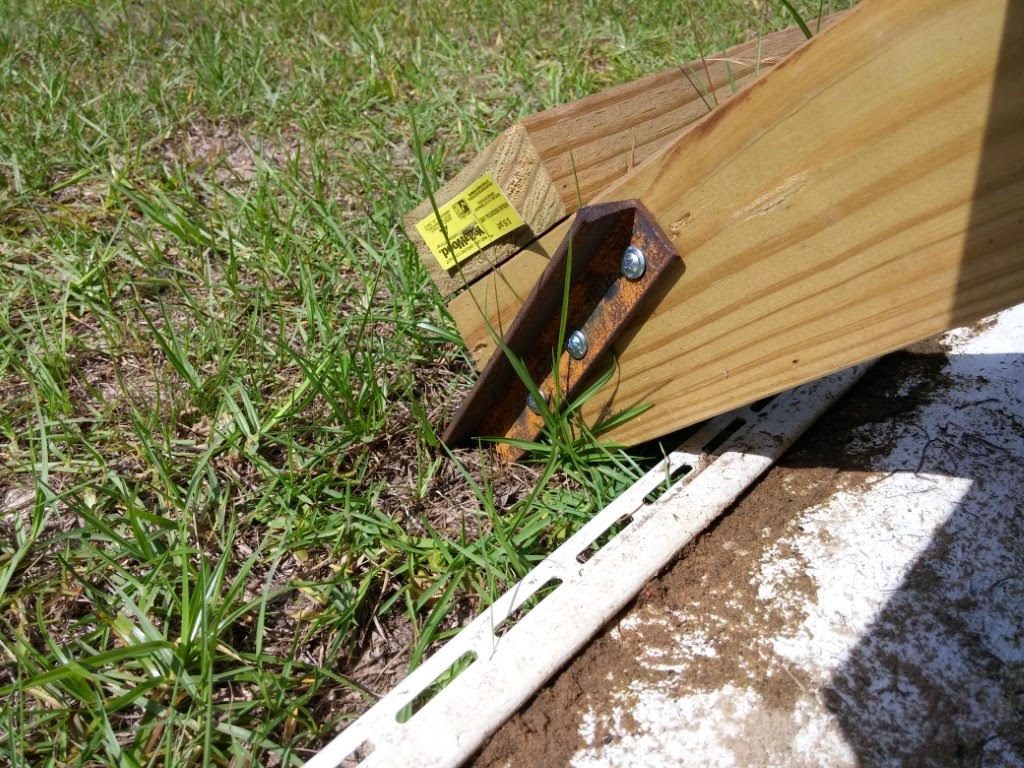John and I have been talking about using solar power to survive in relative comfort after a storm. In my efforts to mostly eliminate my old 24v solar power system I realized I was putting together what would make a good example for survival power. Why did I not eliminate the 24v system completely? My solar electric launch, Sun King, is in the Solar Shed and needs to be kept charged up in the dark shed. In return, the onboard inverter runs my shop air compressor. Anyway, the old control board is coming down as my control room gets walls and a bit of civilization. Yup, Man Cave.
First, let’s talk about panels. Are your panels going to survive the storm? My Solar Shed PV shingles are rated for 60 mph, so there is a real good chance that winds from the right direction could do away with some or all of them. What about conventional panels? Believe it or not, there have been post storm studies to see what stayed put and what blew away. Click on the link for some interesting reading. https://rmi.org/wp-content/uploads/2018/06/Islands_SolarUnderStorm_Report_digitalJune122018.pdf
What I am proposing here is not storm resistant. In fact, my plan is to unplug and unbolt the panels and store them in a safe place. Under the house? Under the bed? I go for under my pickup truck which gets parked in a gulch, the panels duct taped into a heavy mass. Heck, we’ve even parked airplanes down there. The winds always blow right over anything we put down there. This won’t work if you are a coastal dweller. Maybe if you are a coastal dweller you should stuff them in the minivan and be somewhere else when the storm comes!
So, imagine the storm is passed and the winds have died down. Your house is livable, but there is no power. You want some lights and the fridge running at least. What I am suggesting here won’t run your central air, but if you have a 5000btu window unit, it will run and make a big difference, despite the small size.
First, retrieve your solar panels. You can make some temporary mounts by nailing up some 2x4s. There are usually plenty of them from houses that blew apart. Heck, you can even lash up some saplings using those Scout skill you got when you were 12. You just want your panels to be reasonably stable. I have put some flat on the ground for over a year. Whatever works. In this case, for my boat charger, I ran 3 treated 2x4s diagonally, nailed to the bottom of the solar shed eaves. Deck screws or ring shank nails are good about staying where you put them. I then put crossbar 2x4s spaced for the length of the panels.
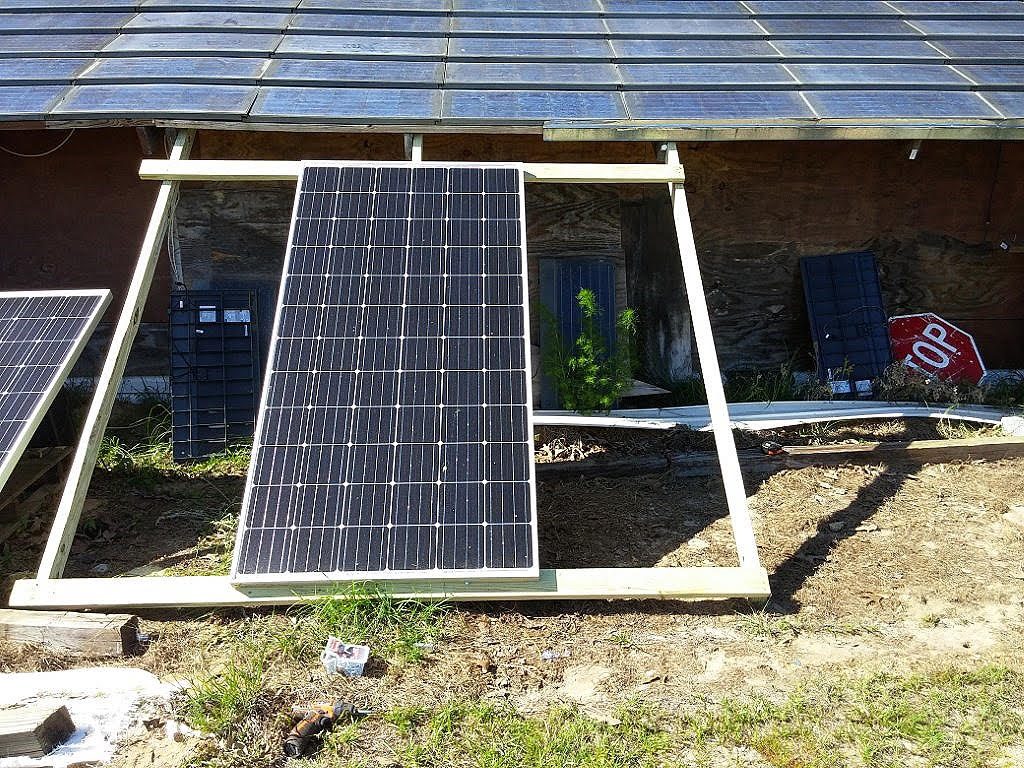
If you routinely have some strong winds you might want to drive some angle iron into the ground to hold down the bottoms.
The panels, I use 3 to the rack, can be held in place with aluminum angle, about 2” lengths, and self drilling screws. I use longer screws in the wood. Don’t have a power screwdriver or cordless drill? How can you live that way???
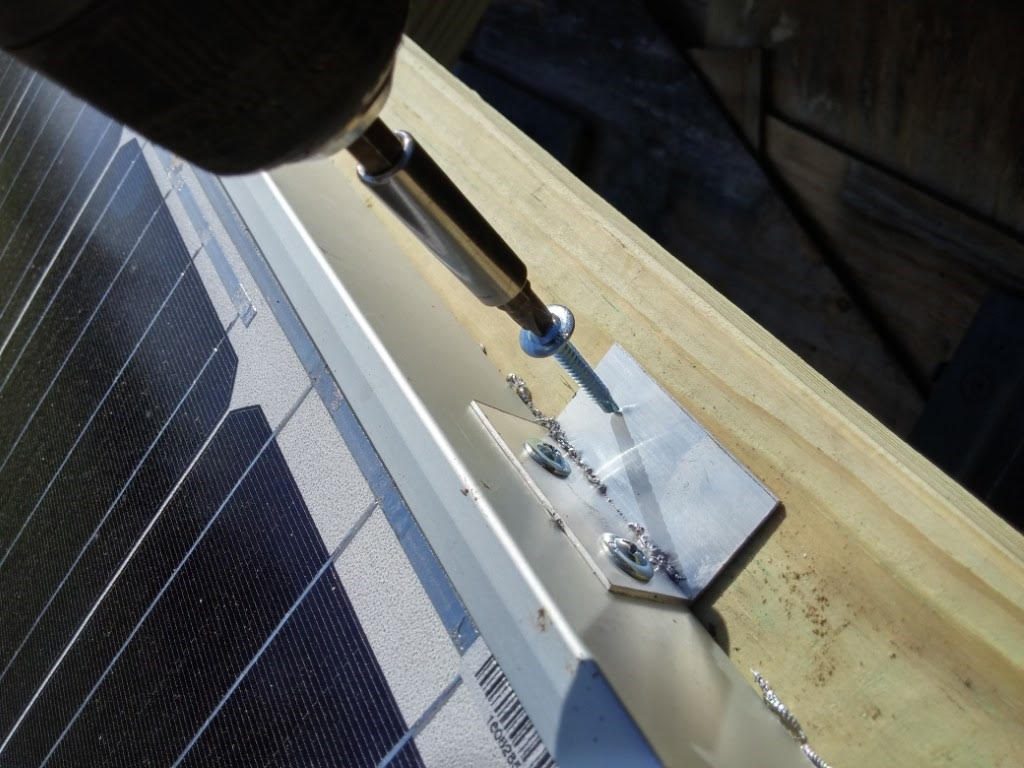
You could just as easily screw the boards to fence posts or lean them against a dead car, in a pinch. Not shown, I also screwed the panels together.
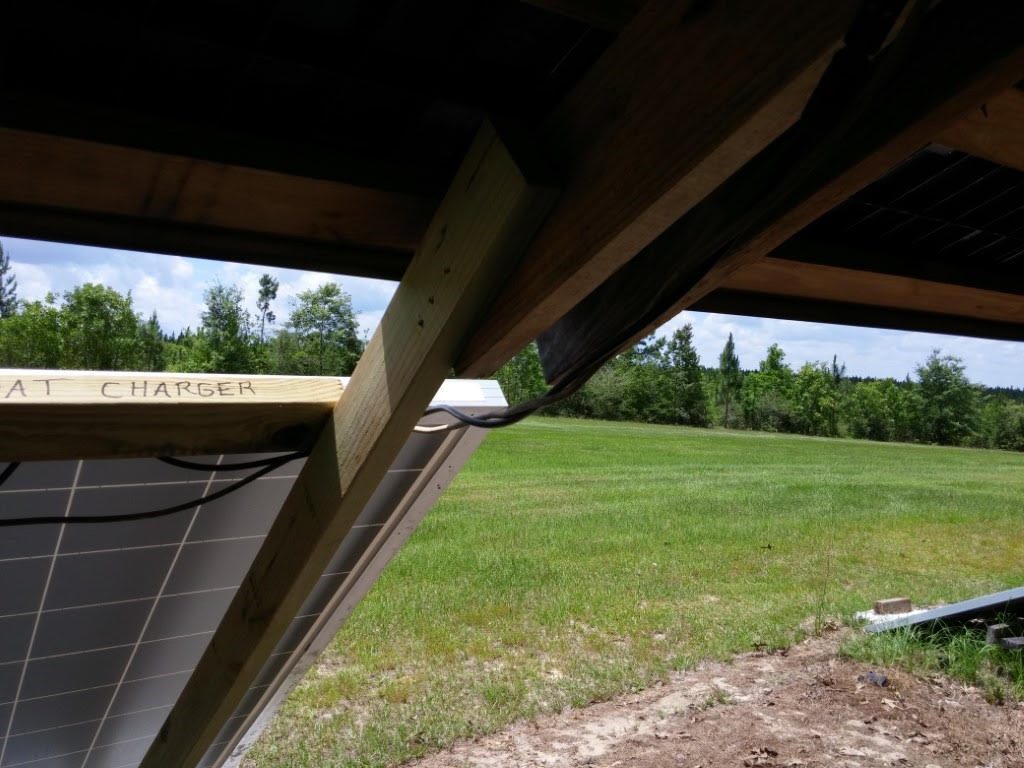
Finished product. Well, it needs paint on the wood for protection if you keep it long term.
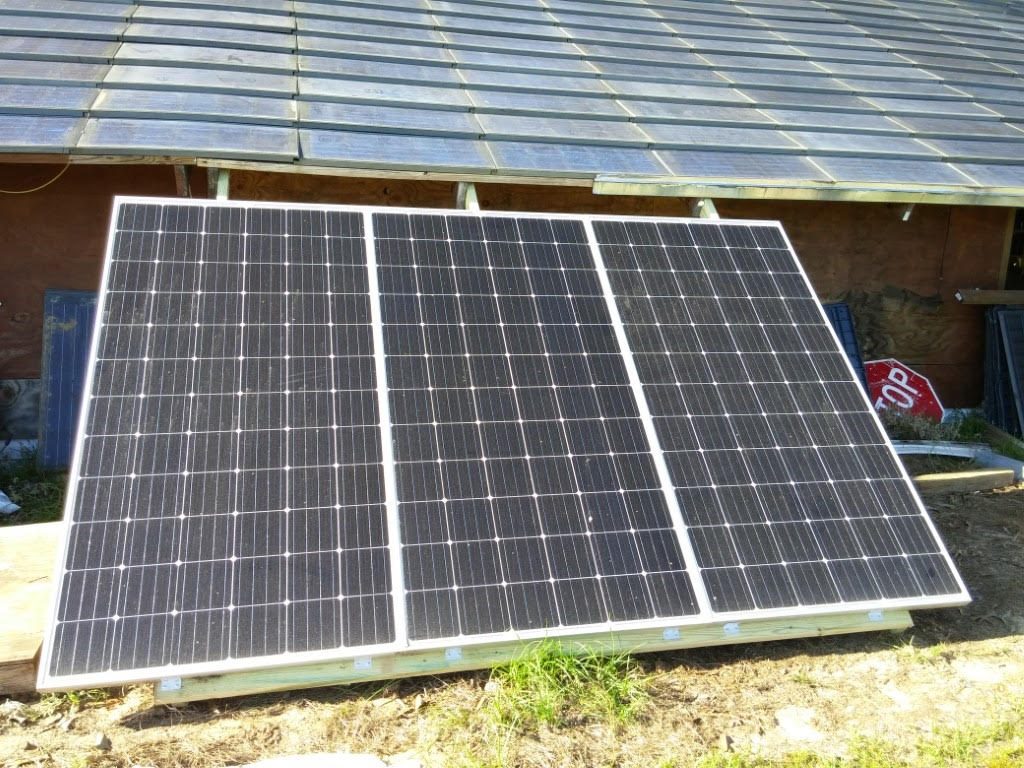
You can see I still have 6 more panels to put up on racks, at this point. The 1500 hp fan has not blown over the panels just leaning, so I am pretty confident about the ones on the racks.
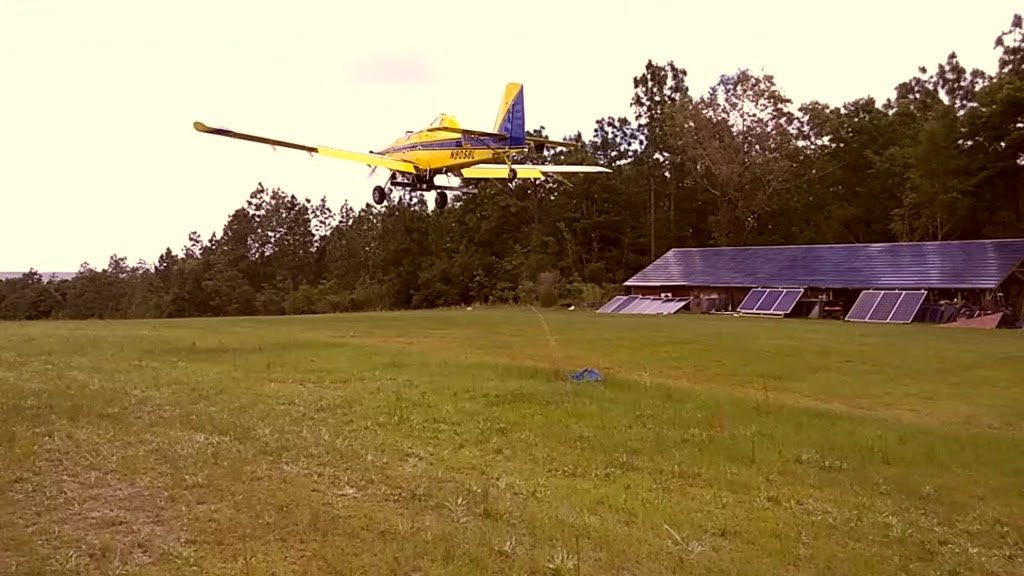
Out of the weather, I used a scrap of plywood, 2 common fused disconnects, like you might use for an air conditioner compressor, and a cheap charge controller left over from evaluations for my Solar Yacht project. It’s a decent little controller, but the displays fail over time. ALWAYS connect the battery first so the controller can determine what voltage you are running, and THEN connect the panels. Although they look nice and professional, you don’t need preprinted placards to label things. A felt marker will get the message across. Ok, ok, I will put some printed labels up. There are websites and programs that let you design and print your own labels, signs and placards. You could premake the whole assembly on the plywood, with quick connectors and keep the unit in a safe place for rapid setup after the storm.
“Goof Off” and fine steel wool will clean off that tacky Magic Marker labelling when you get some proper decals.
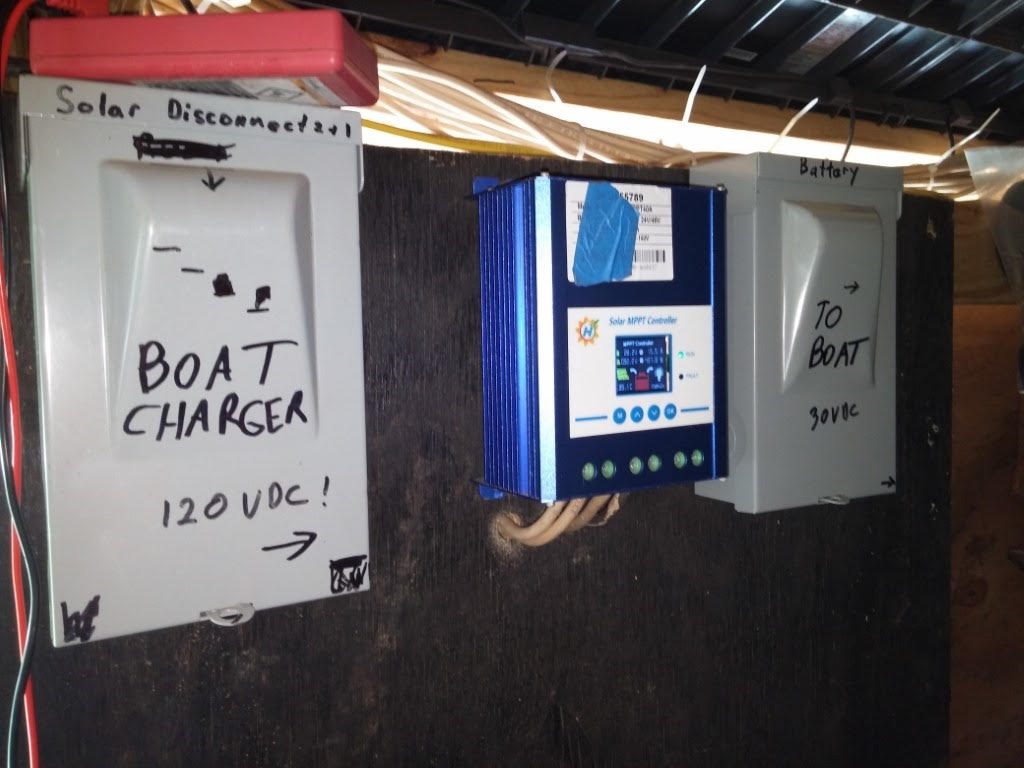
If you are the suspicious type, you note that you don’t actually see any batteries. They are in the boat, 350amp-hours of 8v golf car batteries. This is actually how you might do batteries in a survival situation. If you had a battery bank, it is unlikely that it went away. If not, there will be cars, trucks, tractors, etc that have been crushed or flooded. Maybe your own. They can be a source of batteries. ASK, if possible. Don’t get shot for taking a battery! In this case, the boat has batteries and an inverter, so I am good to make power. I have a 2500 watt inverter for my 12v truck, when it is running. I have run a fridge with that and, more importantly, a coffeemaker, but you don’t really want to leave your car running. You did fill the tank before the storm, didn’t you? But, you still don’t want to leave it running. This little rig pictured above can charge the battery in your vehicle to run the inverter to run the fridge and Mr. Coffee. Microwave, too!
A golf car is a perfectly wonderful survival aid. Not only does it provide a LOT of battery, you can bolt on a 48v inverter for the newer ones (there are 36v inverters, but they are harder to come by) for portable power. There’s the transportation value, too. This same charging rig will automatically adjust to 48v operation. NOT ALL charge controllers go up to 48v, so check before you buy.
This 2500 watt modified sine wave inverter got painted red with the rest of the car, and ran the microwave just fine.
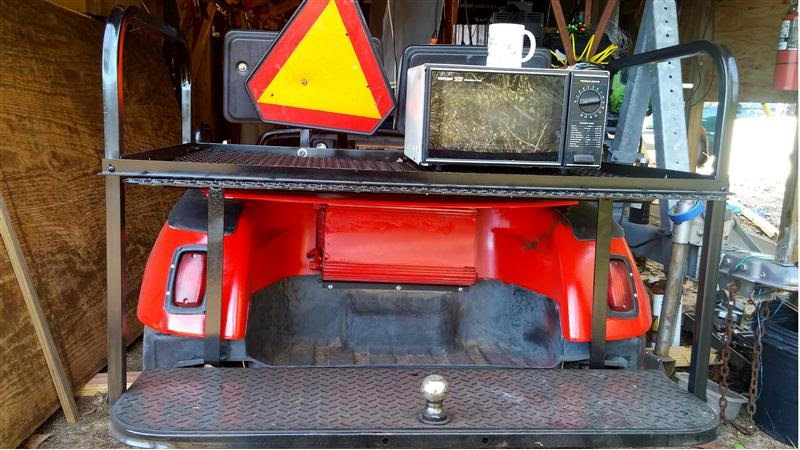
Oops, reality check, yeah my 2500 watt truck inverter will run those appliances, but what about the charging? 3×270 watt panels /12= is 67.5 amps. It is a 40 amp controller. Use just two of the panels instead of 3 and you are good. You math geniuses will note that two panels can produce 45 amps at 12v, but they won’t at that angle and if you use a pwm controller you’ll not get even close. On the 24v system it has room to spare with all 3 modules. Don’t forget to calculate this stuff and don’t forget to have all of the tools, fasteners, cables and connectors that you need. A dry run drill is a good way to check. Plastic totes are good for holding the kit, less panels and 2x4s.
OK, so what does this cost? I scrounged most of it. I had the disconnects left over from something else, but I think they are maybe $10 at Home Depot/Lowes. The charge controller is an MPPT unit that I already had. Cheap pwm controllers are readily available for a throwaway system like this, or you can get an industrial strength controller for maybe $500. Your choice. In a pinch, if you match the panel voltage to the battery voltage and keep the load up, you can get away without a charge controller, but be forewarned that inverters can be fussy about their voltage range and batteries can be killed from over or under charging. Batteries, ideally, are something you already have in a car, boat, tractor, golf car, RV etc. You might get an inexpensive survival inverter, even if you have a nice one in a PV power system. We are talking about backup, here. A fridge and a microwave WILL run on the so-called modified sine wave models. John does not have the absolute cheapest inverters, but he has good prices on inverters with a good track record. MOST cheap inverters you see on ebay have drastically exaggerated ratings. If you don’t have any of this stuff, the Puerto Rico kits that John put together after their storm are pretty much everything you need at a great price.
Ok, how do you get the power into the house? If you have a generator plug and a transfer switch you just plug it in with an appropriate cable. The circuits on the transfer box need to be within reason for the amount of power you have. Forget the clothes dryer, range and central air. Concentrate on lights, microwave, fridge and coffee pot. (Coffee makers also make hot water for Ramen noodles, soups, teas, etc.) DON’T have the generator plug? Use a HEAVY DUTY (12 ga) extension cord and run it in through a window. Use an outlet strip to plug in the fundamental loads. OR don’t use the outlet strip, which guarantees nobody will run Mr. Keurig and the microwave and fridge at the same time, possibly blowing a fuse and ending it all. Umm, you do have a spare fuse, don’t you?
OK, these are just some things to think about as Hurricane Season approaches. There are so many ways to prep for power after the lines go down!

